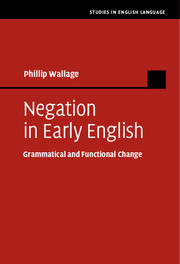Book contents
- Frontmatter
- Dedication
- Contents
- List of figures
- List of tables
- Acknowledgements
- Abbreviations
- 1 Introduction
- 2 Quantitative Evidence for a Model of the Jespersen Cycle in Middle English
- 3 Distributional Evidence for Two Types of ne: Redundant Negation
- 4 Distributional Evidence for Different Types of not
- 5 The Syntax of the Early English Jespersen Cycle: A Morphosyntactic Feature-based Account
- 6 The Role of Functional Change in the Jespersen Cycle
- 7 Negative Concord in Early English
- 8 Negative Inversion: Evidence for a Quantifier Cycle in Early English
- 9 The Loss of Negative Concord: Interaction Between the Quantifier Cycle and the Jespersen Cycle
- 10 Conclusion
- References
- Index of names
- Index of subjects
6 - The Role of Functional Change in the Jespersen Cycle
Published online by Cambridge University Press: 13 July 2017
- Frontmatter
- Dedication
- Contents
- List of figures
- List of tables
- Acknowledgements
- Abbreviations
- 1 Introduction
- 2 Quantitative Evidence for a Model of the Jespersen Cycle in Middle English
- 3 Distributional Evidence for Two Types of ne: Redundant Negation
- 4 Distributional Evidence for Different Types of not
- 5 The Syntax of the Early English Jespersen Cycle: A Morphosyntactic Feature-based Account
- 6 The Role of Functional Change in the Jespersen Cycle
- 7 Negative Concord in Early English
- 8 Negative Inversion: Evidence for a Quantifier Cycle in Early English
- 9 The Loss of Negative Concord: Interaction Between the Quantifier Cycle and the Jespersen Cycle
- 10 Conclusion
- References
- Index of names
- Index of subjects
Summary
Introduction
This chapter examines the role of functional change within the Jespersen Cycle. It investigateswhether the diachronic stages identified in Chapters 2–5 perform distinct pragmatic or discourse functions during the periods when they compete, and whether changes in their functions explain changes in the distributions of ne, ne…not and not during the course of the Jespersen Cycle. In particular, I examine how functional change contributes to the grammaticalisation of not. Using logistic regression, we can model pathways of functional change within the Jespersen Cycle predicted by different functional analyses. The distributions of negative markers in diachronic corpus data provide an empirical basis against which to test these models, just as they did when we modelled the formal changes within the cycle in Chapter 2.
Within competition models of change, the null hypothesis is that functional change should arise simply as a consequence of morphosyntactic competition, without stipulating any further mechanisms of functional change. Functional constraints should observe the Constant Rate Effect just like the grammatical constraints in Chapter 2 did. Thus the relationship between functional change and the formal model of the Jespersen Cycle as morphosyntactic competition I proposed in Chapter 5 is crucial. I argue once we dissociate functional and structural competitors, in the way a morphosyntactic feature-based analysis allows us to do, functional change arises through competition between forms that are structurally equivalent but functionally distinct.
The idea that functional change plays a role in the grammaticalisation of new negative markers dates back to Gardiner (1904) who says in respect of the French negatives pas and point:
These words, from the Latin passum and punctum,were originally adverbial accusatives placed at the end of negative sentences for the purposes of emphasis, just like the English “not a jot”, “not a straw”…Pas and point…next lose their emphasising force, and become mere adjuncts of the negative words [French ne].
(Gardiner, 1904, 134)More recently, this idea has been taken up by Detges and Waltereit (2002), Kiparsky and Condoravdi (2006), van der Auwera (2009), Hansen (2009) and Hansen and Visconti (2009).
- Type
- Chapter
- Information
- Negation in Early EnglishGrammatical and Functional Change, pp. 112 - 147Publisher: Cambridge University PressPrint publication year: 2017

